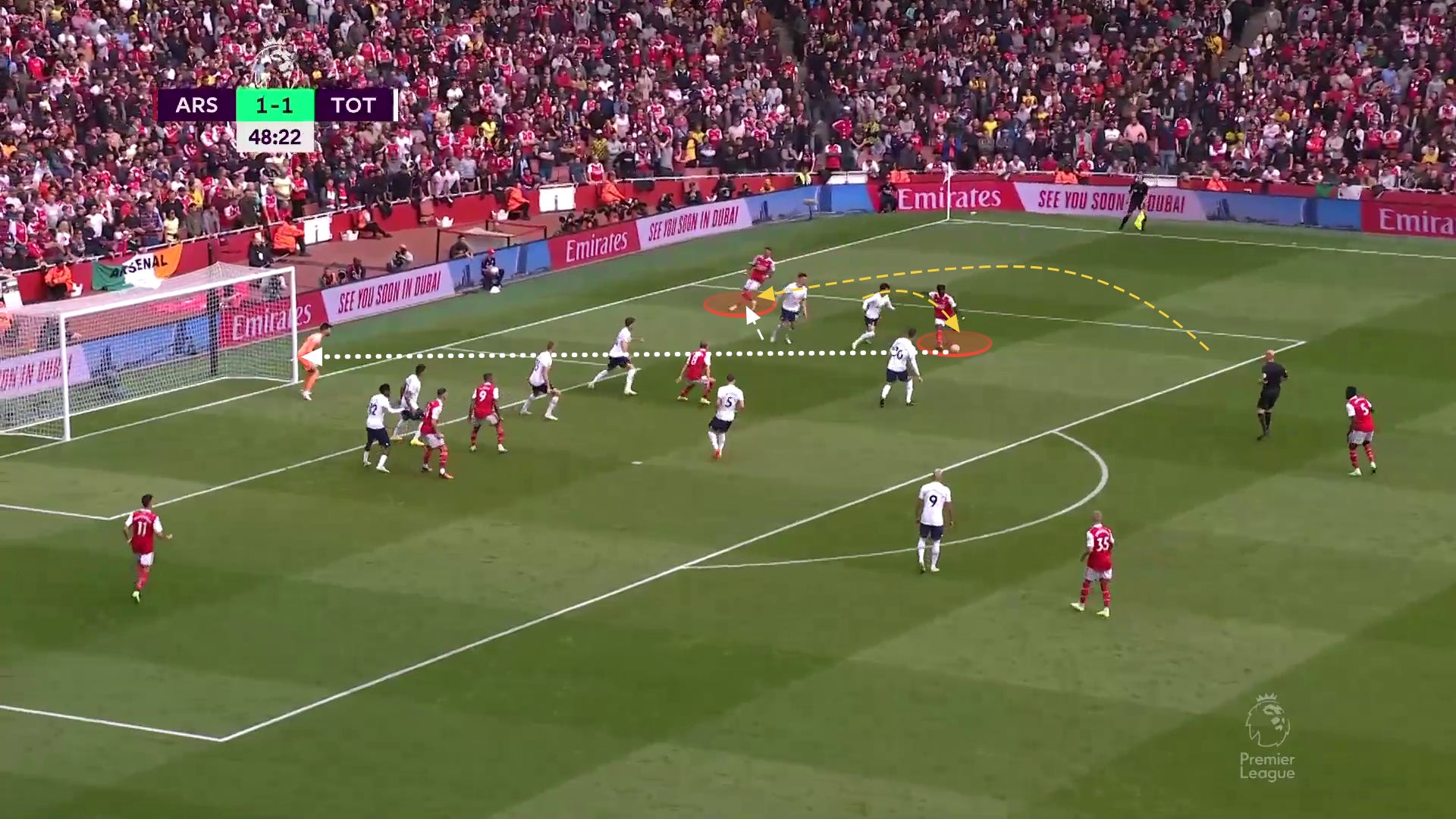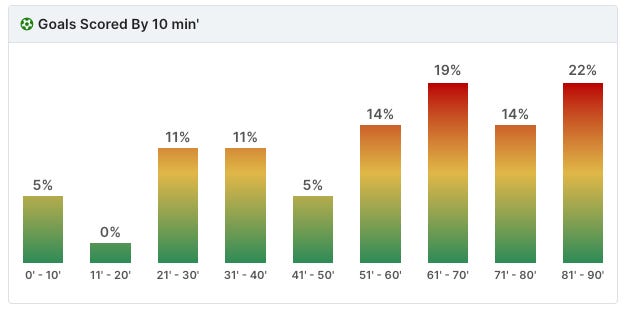Now that I’ve written up long scouting reports on the likes of Félix, Danilo, and Mudryk, and they’ve all found homes elsewhere, it’s time to use my powers for good. Let me know if there are any players you are really hoping Arsenal avoids, and I’ll write up something to seal the deal. 🥴
In all seriousness, as I shared in Substack’s chat feature: not matching the full package for Mudryk is completely understandable from Arsenal’s side, but this was somehow equal parts disappointing, surprising, and inevitable. I’m sure I’ll write something up on potential targets this week.
But enough about non-Arsenal players. It’s game day. More than that, it’s NLD day.
I’ll figure out some way of differentiating the weekly long-reads (like the piece on the left-8 from Thursday) from these notes columns, but for now, here are some last-minute things on my mind heading into the game.
1. Sending help for Saka
In the last bout of Premier League action, Bukayo Saka was marked by 6’7” Dan Burn, who was actively supported by Joelinton and one of the year’s top defenders in Sven Botman. He still provoked moments of danger. This week, he goes up against Perišić, Lenglet, and Son.
(Edit: we got our first glimpse of Conte's strategy out there in pre-game, with Sessegnon starting over Perišić)
Antonio Conte is faced with a bit of a Sophie’s Choice out there: does he let Saka operate in isolation, or does he break his positionally disciplined 5-4-1, which he prefers not to do for anybody?
Much of their team identity is about having the patience to stay in position and ensure that lanes don’t open up in the box. But Conte made a big exception in the first Derby, recognizing the danger and immediately running over help to Saka. That led to the first Partey goal:
That was no good for Spurs, so they changed a bit in the second half, allowing Saka to isolate, which led to White overlaps, which contributed to the second goal (and other chances):
The first time he gets the ball out there, it’ll be interesting to see how it plays out.
2. Shot selection
As we covered last time, Spurs don’t actively challenge long-distance shots: they’re content with letting their opponents bang in low-percentage shots into a crowded block.
They allow the furthest distance average shot (19 yards) and the lowest-percentage shots on target (30%).
While in the block, much of the philosophy is about boring-slash-frustrating the opponent enough to get them to try shots like this, by Eze:
(It didn’t go in.)
Arsenal must be patient, and only rip them after a strategic move that opens up a lane, as they did with the Partey goal.
3. Effectiveness of the counterpress
There are likely to be a few harrowing moments of tracking back against a Spurs counter. The best place to defend them is to make sure they don’t happen in the first place, by first holding possession and then by disrupting moves as far upfield as possible.
The question: in the moment after Spurs win the ball, can the midfield — particularly looking at Zinchenko and Partey — hassle the ballcarrier enough to stop the initial pass, often to Kane, from getting out?
When Kane is given a moment’s respite in this spot, he’s one of the best players in the world:
Here’s the example we discussed against Brighton. Not only did the attack get nullified, it was quickly a goal at the other end against an out-of-shape opponent:
Whether or not these pressures “get home” could very well decide the game.
4. Composure against longballs
Fear of the counter can often cause more damage than the counter itself. The coordination of the Arsenal offside trap has gotten increasingly better as the season goes on. Against United, you could feel the White/Gabriel/Saliba trio still feeling each other out. Here’s what we wrote before the last NLD:
One might think that long balls are a natural advantage against a high pressing team, but it's often the opposite. While being pressured and offside-trapped, passing over a high line and into space is often a low-percentage endeavor, and a cheap way for the pressing team to regain possession. By my count — okay, by fb-ref's — Liverpool's opponents missed 1,736 long balls last year.
Maintaining composure on these will be the order of the day. Per Opta, just 22% of Spurs’ successful passes have ended in the final third of the pitch in the Premier League this season – that’s only higher than Leicester City (20%).
For the foul on Son that got Holding sent off last year, here is where the ball landed.
The panic wasn’t justified.
Against Newcastle, the CB duo was mostly stellar: balancing their usual feistiness (Gabriel) with level-headedness (Saliba, who may still be harboring some rust, but looked to be rounding back into form). Gabriel picking his spots with his midfield lunges will be key.
5. Quick turns of play
Tottenham doesn’t run a pure low-block at this point. They’re trying to build more energy forward to enliven the season, can press a bit, and have won the possession battle in their last six games. I would expect a little more forward activity in neutral situations than in the contest at the Emirates, particularly as the game goes on.
As we covered last time, when a team drills a low-block at length, it’s best to attack when they’re out of shape. There are a couple times to do that:
Quick throw-ins and keeper play: Putting the ball in play immediately after getting it is a good way to catch runners in transition and exploit lanes.
Changing play after a field crunch: Tottenham will crunch the field for a settled throw-in, and lean when they think the opponent is in a vulnerable spot by the touchline. If Arsenal can get it out of there quickly and switch play all the way across the field, they are likely to have numbers.
Dragging defenders on the dribble while in transition: In a play like below, they defend very differently than when they settle into their block. Because this was in transition, Martinelli was able to drag Romero all the way across the formation, when he’d usually just pass him along. Xhaka cut back into the opened space and put the game away:
6. Pestering Lloris
Tottenham likes to play out of the back as a way of keeping shape, but Lloris has shown some shakiness with ball control this year. They may ultimately decide it’s not worth the risk and ping it long, but if they don’t, Eddie should be running full speed at the man.
Just little pressures like this can be enough for him to spray it into traffic:
7. Other
Is it cheating to have one of the things I’m looking out for be a bunch of things?
Either way, here are some other assorted things on my mind:
The health of Bentancur and Kulusevski: We’ll find this out in pregame lineups. Outside of Kane, these are probably the two most pivotal players on the roster. Bentancur solidifies everything, and Kulusevski transforms their attack from Kane-and-Perišić crosses/heroball situation to a dynamic, unpredictable side that is much more capable of imposition.
Zinchenko/Martinelli/Xhaka: Zinchenko will likely have to track back on a couple through-balls, which will be nervy times. From there, these three continue to gain fluency in rotations with one another, and some hard-to-defend rotations may just be what the doctor ordered against this block. They aren’t likely to be facing Emerson Royal again — it’ll probably be Matt Doherty.
Ødegaard: The skipper was on an all-world run before getting effectively crowded and slowed in the Newcastle game. Can he prove that to be a momentary blip?
White vs Son: Son has notably struggled this year. Some of it appears to be form and fatigue, some of it that Perišić is crowding the spaces he likes to occupy. Regardless, he’s still Son, and is nonetheless a tough task in transition against Arsenal’s most consistent player.
Aerial duels and set pieces: Nothing interesting to say here. Two elite teams will be battling it out.
Countering up the middle: Once midfielders commit forward, the Spurs attacking shape leaves the middle of the pitch vulnerable to counter-attacks.
Late action: As you may have noticed, Tottenham likes to score late. This is for a few reasons: one, they can dig holes for themselves and require late goals. Two, some of their players genuinely can keep running when the opponent gets tired. Three, the cross-to-Kane’s-head thing can be more effective against a tired backline. Can White/Saka/etc get a leg out for Perišić’s crosses?
Overall, if this one follows the history of away NLD’s, it’ll be a tough one. There’s every reason for confidence—Arsenal’s consistent form and tactical superiority, Tottenham’s meandering quest to rediscover an identity—but all the run-up melts away when the whistle blows.
While Arsenal’s gameplan is set, Conte has some options. In the first few minutes, it’ll be interesting to see if he’s aiming to play on the back or front foot.
As usual, this wound up a lot longer than I expected to be. No ragrets. Thanks for reading.
Happy grilling everybody.
Be good.
🔥











